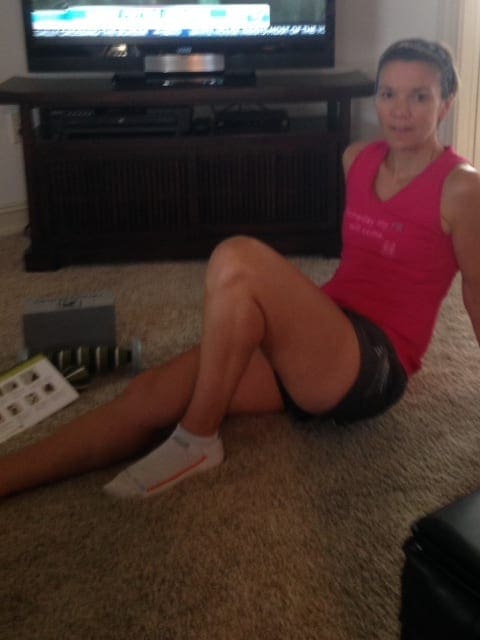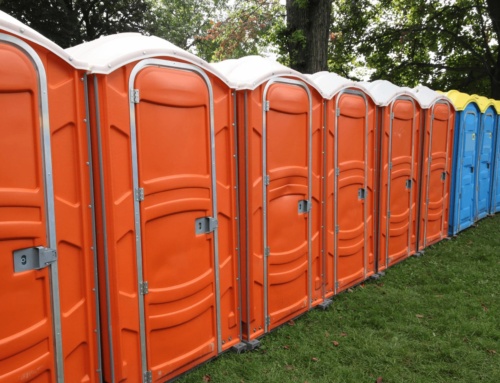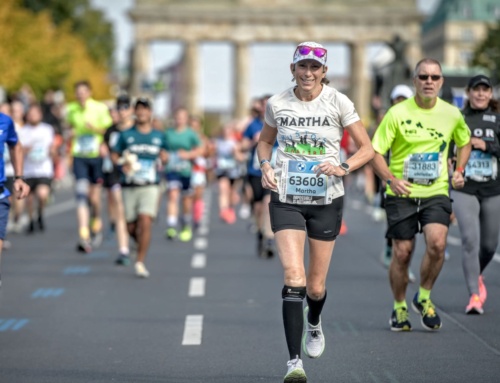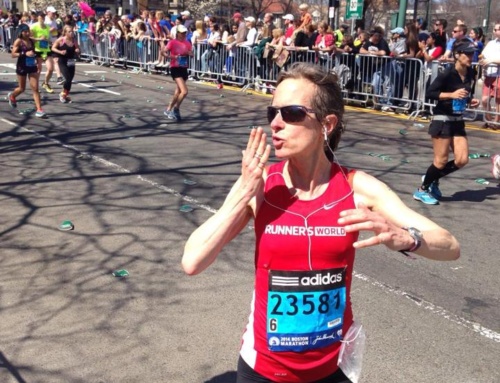Nicole Hart, a mom on the move in Boiling Springs, Pennsylvania, had a massive pain in her butt for months. “I haven’t been able to do any real speed workouts, just all easy runs,” she told us. “Foam rolling, stretching, core exercises are helping my Piriformis Syndrome, but they’re not perfect. Sitting is the worst for it!” Sounds like she was the next perfect recipient for the AMR TriggerPoint Traveling Ultimate 6 Kit.
What Piriformis Syndrome is: When one muscle—the piriformis muscle, which is your in your butt near the top of the hip joint—gets too aggressive and compresses the sciatic nerve.
On a scale of 1 (a hangnail) to 10 (hospitalization required), I would rate this injury a: 5-6 at its worst. When I was attempting to run, it stopped me in my tracks. I limped home. When I wasn’t running, but had been sitting for an extended period of time, it was a 2-3. Even though the pain wasn’t as intense, I still felt like I was limping.
What causes it: For me it was just an overuse injury; too many miles; not enough pre- and post-run stretching; not integrating cross training and strength training into my routine. When it first hit, I was training for a full marathon last fall. I ran my last 20-mile training run in preparation for the marathon, and couldn’t run without pain for months after that. Also, sitting too much seems to have aggravated it. I sit often in the car, while waiting for kids at their activities, or while doing work online.
Dr. Wikipedia weighs in with this important explanation: Runners, bicyclists and other athletes engaging in forward-moving activities are particularly susceptible to developing piriformis syndrome if they do not engage in lateral stretching and strengthening exercises. When not balanced by lateral movement of the legs, repeated forward movements can lead to disproportionately weak hip abductors and tight adductors.Thus, disproportionately weak hip abductors/gluteus medius muscles, combined with very tight adductor muscles, can cause the piriformis muscle to shorten and severely contract. Upon a 40% increase in piriformis size, sciatic nerve impingement is inevitable. This means the abductors on the outside cannot work properly and strain is put on the piriformis.
What it feels like: A real pain in the butt. For me, it was a tightness and pain that started in my butt, and travelled down the back of my leg, making even walking uncomfortable at the height of the injury. While the pain would affect my gait, and force me to stop. When not running, I could feel almost “normal”—until I would try to run.
You might have it if: Your butt hurts, especially when you’re running or after sitting for long periods of time.
A good self-test: To differentiate piriformis syndrome from other causes of sciatica (such as a herniated disc in the low back), a simple test you can do on yourself is to pull your knee toward your opposite shoulder while lying on your back. Hold the involved knee towards the opposite shoulder for about 30 seconds and if piriformis syndrome is present, you’ll feel a slight tingling along the outside of your leg.
When I would try to stretch my piriformis, it just was so tight. I would feel a definite pain and tightness in the middle of my glutes. Also, I could never get a “normal” stride going on my runs.I kept hoping it would loosen up, and it eventually didn’t once I had let the problem go for a while. The day after a run, I could barely walk without limping.
What and how to roll: For me, rolling with the TP Massage Ball before running worked the best. Just before I headed out, as I was sipping Nuun, I would just take a few minutes to do the 4 positions/actions: External Leg Rotation, Clam Shell Out, Clam Shell In and Pivot. I am happy to report that within a week or two of rolling with the TP Massage Ball before my runs, I felt so much better.
It really didn’t take long at all. Ideally, I should’ve rolled both sides, not just the affected side, but I usually only did that side. The key was to roll slowly, deeply and while taking slow, deep breaths. There wasn’t any need to rush, since the whole think only took a few minutes.
Occasionally, I would take time after a run to roll again, this time experimenting with some of the other tools in the Ultimate 6 Kit, including the soleus manipulation with the FootBaller and the Quadriceps/IT Band Manipulation with the QuadBaller. I even tried the psoas manipulation with the ball, but don’t really think I found the right spot.
What else works physically: I had physical therapy appointments for 3 months, 1-2 x per week. During those appointments, the PT used ultrasound, massage, and stretching at first to relieve the initial pain. Eventually, we worked on strengthening my core and hips. I was encouraged to do hip bridges with a resistance band and clam shells at home.
In January 2014, I resumed running, but continued to have discomfort, especially when I ran 2 days in a row. So, from January-June I ran 3x per week, with no high mileage, no speed work. I crosstrained with TRX, yoga, and did core exercises at home at least 3 times per week. This is the routine I really like.
For the last 3 weeks, I have been able to run five times weekly. I have consistently rolled with the TP Massage Ball before my runs, did a few dynamic stretches while waiting for my GPS satellites to kick in, and then stretched and did my core exercises post-run at least three times a week. This is really working for me. I was able to run a 5K race last weekend with absolutely no pain, which is huge.
How I coped mentally: Honestly, until just a few weeks ago, I was feeling pretty down about my running. Yes, I was able to run, but the runs were lackluster and often difficult to get through. I felt that I had lost my mojo. I just kept seeing my runner friends getting fitter and faster, including one who qualified for Boston. Meanwhile, I was nursing this injury for months and getting very discouraged.
How to avoid it in the future: As with any running injury I have had, I know prevention is key. I am going to continue to do my core and strengthening exercises regularly, and I have plans to order an Ultimate 6 Kit for myself now that I have to send this one to the next Mother Runner. Secondly, I will listen to my body and take rest days, work out tightness and deal with what’s going on, instead of continuing to run through it. I’ve always known this, and someday I will master this skill.
If you’ve suffered from a pain in the butt, how did you recover? Any other tips or ideas to share?
We’ve covered IT Band Syndrome, Plantar Fasciitis, shin splits, and hamstring strains in previous Ultimate 6 episodes, but if you have another running injury that needs some TLC from the AMR Ultimate 6 Kit, email us at runmother [at] gmail [dot] com, and we’ll see if we can get some relief sent your way.
Also, if you’ve got your eye on—or your muscles are longingly aching for—some TriggerPoint products, grab 20% off with code AMR20 at checkout on TriggerPoint.com









Listening to this right away on my drive to work! I have this often, and looking forward to this episode. Periformis stopped me at the Eugene Holiday Half a couple of years ago at mile 6.5 and I hobbled to the end going from a sub 2 hour to a 2:30ish if I remember correctly. Overuse will cause this and it never really goes away :(
The good self test is also a great stretch before runs for future management and prevention.
Thank you for this article! I have had nagging butt pain for years, especially when sitting in the car for long periods of time. This article explains why. My husband, whose 2nd job is a XC coach, is a big advocate of stretching in general, and the foam roller in particular. I have used the Trigger Point foam roller every morning for the last few years, and it really seems to help. With the 20% discount, I am going to get him the hip/lower back kit for his birthday :)
The roller also feels good on my feet, particularly the outer edges, where I have calcium deposits.
Thanks for this. I believe in my TP ball and foot roller, but boy would I love to see how to use it best for achilles issues! Thanks again AMR.
Thank you for this article!!! This is EXACTLY what I’m going though right now!!! Whew.. This helps me out so much! How can I find out more about the exercises ??? Thank you!!
This is my issue too – and it also causes me some nagging pain in the side of my hip that causes limping while walking the day after a run. I’ve found that strengthening the glute medius region, along with rolling out the piriformis area, has me almost back to normal.
The strength exercises I’ve been doing for that region go by the name of the “Myrtle” routine and there are several videos online that show exactly how to do them. Easy and quick, but super effective at calming the pain in my butt!
Wow! This sounds so much like my story. Butt pain while running and at it’s worst when walking. Physical therapy and strength training for the hips and glutes helped but it was the trigger point massage ball that really did the trick. I still use it for flare ups and especially now as I am getting back to running after my second baby. Keep using the ball and good luck!
I have this issue and it is excruciating when driving my husbands compact Honda. Not so bad in my suburban!
I really really could use this!! Thanks for the chance to win! I visited a physical therapist after my last marathon, and this time around I am very vigilant about doing stretches right after every run, and doing clamshell exercises. This has kept it at bay for this training cycle, but on those long runs it’s still a minor issue that I wish would go away!!
Thank you Sarah! Going to go look for them :)
Thank you so much for this post. I’ve had this on and off for a few years. I was never certain if this was an aftermath of very loose hip ligaments during pregnancy or sitting for too long while driving to visit family… probably a little of both. I’ve been stretching and strength training, but will definitely look into the myrtl routine and TP ball… I’m so glad I found this post!
Love my foam roller for all manner of aches and pains, I always feel better afterwards… (Although not so much during!!)